

One of my favourite pastimes when I was small was running a stick along the bars on a set of railings – the faster you ran, the better the noise!
G & K made railings for all manner of houses and institutions, schools, parks and even cemeteries. Nowadays steel palings are popular. Network Rail are a great customer for these but in days gone the appearance was combined with the effectiveness, especially around public buildings.
In May 1862 a quote was sought for the provision of well over 850 feet of Iron railing to surround the Cathedral Yard in Exeter. In those days railings were springing up everywhere, though it is hard to find examples of Garton & King’s work still around, but not so hard to find photographs. St Thomas Church once boasted a fine length of railing alongside Cowick Street – what is there today is but a shadow of the former glory. Teignmouth Pier was another customer and less elaborate styles were to be seen along Bonhay Road. Keep your eyes open for the sepia pre-war photos of such places as The Eye Infirmary, the old Devon & Exeter Hospital, Wonford Hospital and many of the graveyards – St Davids Church comes to mind. In the country field railings were everywhere – still to be seen nowadays – not too impressive visually but quite effective and durable. Killerton or Powderham have many a mile still.
 3 Pennsylvania Crescent
3 Pennsylvania Crescent
No 3 was my Grandfather’s House up until 1964. The more ornate railings and gates were commandeered in the Drive for Metal in the 2nd World War. The photograph is of the original gates and railings – whether they were made by Garton & King I cannot say, but the lad in the picture is my Uncle and I would date the picture around 1925.
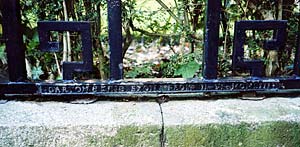 3 Pennsylvania Crescent
3 Pennsylvania Crescent
In 1953 – I’ve converted the date from Roman Numerals for the benefit of the uninitiated, actually the 2nd of June, Garton & King made a new set of Railings and Gates and the inscription reads literally “GARTON & KING EXETER MADE THESE II-VI-MCMLIII”
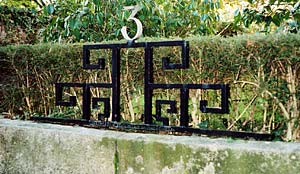 3 Pennsylvania Crescent
3 Pennsylvania Crescent
The later, Art Deco replacement for the Pennsylvania Crescent railings.
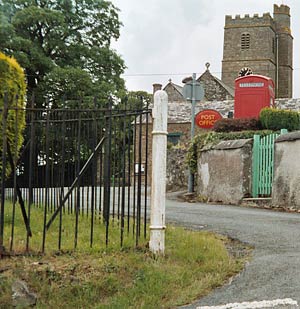 Bratton Clovelly War Memorial
Bratton Clovelly War Memorial
The War Memorial is surrounded by Railings and Posts made by Garton & King. These were put up after the Great War and the lettering is of the Old Style as used on early pre 1924 material. 1924 was the year Garton & King became a Limited Company. No drawings exist for this work and they were discovered by me purely by chance when driving by in a bus in 2007.
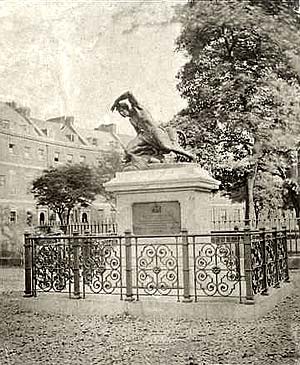 The Deerstalker Monument
The Deerstalker Monument
The history of this artwork is well documented at the Exeter Memories Deerstalker page. I have reproduced the Garton & King photo of the monument and railings, and (below) the Scale Plan of the railings as well.
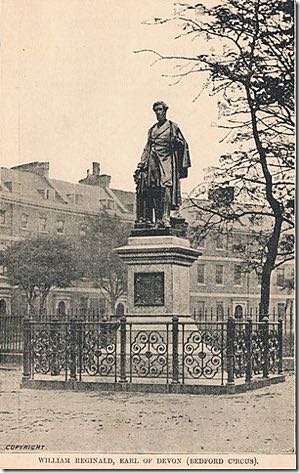 Statue of William Reginald Courtenay
Statue of William Reginald Courtenay
which replaced the Deerstalker statue in 1880, keeping the G&K railings
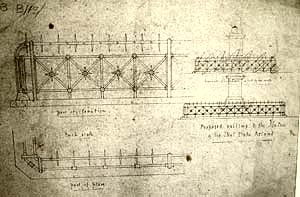 Sir Thomas Dyke Acland
Sir Thomas Dyke Acland
If statues have a life then I’m afraid Sir Thomas’s has had a hard life. Although it is fairly common knowledge that he lost his head for a while, also his finger and other parts of his anatomy, he even lost the hold on his original location and, what is more, he lost his rather grand and ornate railings, the drawing of which is reproduced here.
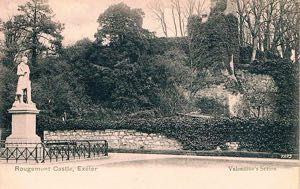 This postcard shows the statue of Sir Thomas Dyke Acland as erected in 1861 in its original position in the middle of Northernhay Park, enclosed by the railings made by Garton & King. In 1895 the railings were removed as the spikes were considered a danger to children. After being damaged by a falling tree in 1930, the statue and pedestal were moved to a new position by the city wall, but the railings are long gone!
This postcard shows the statue of Sir Thomas Dyke Acland as erected in 1861 in its original position in the middle of Northernhay Park, enclosed by the railings made by Garton & King. In 1895 the railings were removed as the spikes were considered a danger to children. After being damaged by a falling tree in 1930, the statue and pedestal were moved to a new position by the city wall, but the railings are long gone!
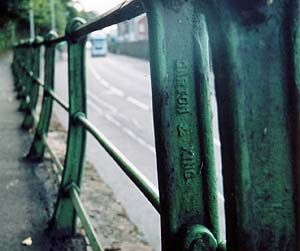 New North Road, Exeter
New North Road, Exeter
These railings extend for a considerable distance along the east side of New North Road. Other examples exist elsewhere within the City. These are by Garton & King (pre 1924) but many are also marked Taylor & Bodley.
 New North Road, Exeter
New North Road, Exeter
Also to be seen is the drawing of this style of Support from the G & K Catalogue.
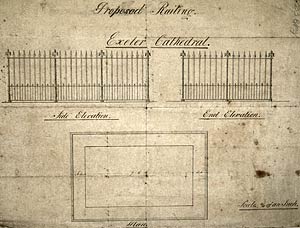 Cathedral Railings
Cathedral Railings
This drawing is for the original Railings surrounding the Tomb of the Earl of Devon, in the Cathedral. The current railings are post war. The location for the supports for the original railings can be seen on the floor where the holes were filled in, leaving a series of regular light coloured circular patches in the flag floor. Another victim of the War effort.
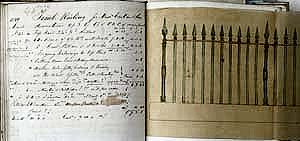 Extract from John Garton Junior’s price and order book
Extract from John Garton Junior’s price and order book
September 1848
Enlargement of these images will show the attention to detail and the skilful drawings that J. Garton Jnr made in a notebook not much bigger than 5 inch x 7 inch.
Tomb Railings feature amongst the pages and one example shown here is for Easton & Son in 1849.
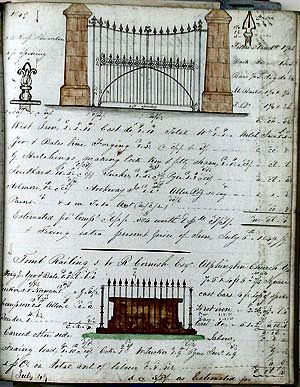 Extract from John Garton Junior’s book
Extract from John Garton Junior’s book
The gates shown were Entrance Gates for a Mr Reade of Budleigh Salterton. Below, another diagram for the Tomb Railings for a Mr R. Cornish Esquire for a Tomb in Alphington Church Graveyard. The page is dated July 1849
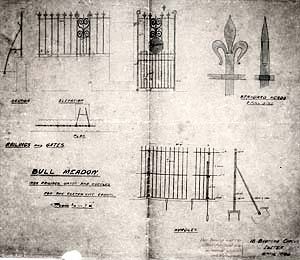 Bull Meadow Pleasure Grounds
Bull Meadow Pleasure Grounds
This Drawing shows the plan for hurdles and gates at Bull Meadow for Exeter City Council. How many times I have passed by I cannot recall and for the moment I must suggest they have long since gone – perhaps some of our more mature viewers may remember them and maybe forward me a photo?
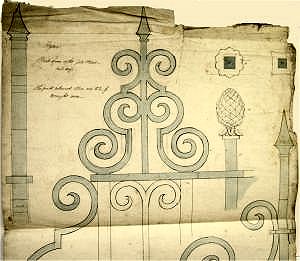
Pynes House, Upton Pyne
Once the seat of Lord Iddesleigh, who died in 1887, Pynes House, Upton Pyne near Exeter is a treasure trove of cast and wrought iron features. In addition to what is still within the property there is an abundance of iron field fencing, pillars and gates, and the front and side of the house flaunt railings and gates designed and made by Garton & King. The ornate style of the railings incorporates Pineapples, a symbol of welcome and affluence. Large stone sculptures of a king-size version of pineapples are nearby. But reflect a minute on what the Garden Museum in Lambeth Palace Road in London has to say. They suggest that very often they are actually pine cones – a symbol that also appears in heraldry signifying the ‘inexhaustible abundance of life in nature’. Well, whatever your view, the design not only appears on fence pillars on the estate but, if you didn’t know about the feature already you’ll now notice them cropping up everywhere, particularly on gate pillars, rooftops, railings, private houses and public buildings. But before you move on to the next item spare a thought - the name of the property is ‘Pynes’ - or should it be ‘Pines’?
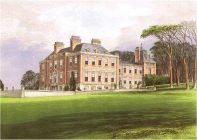 |
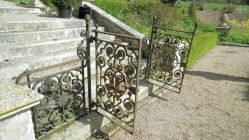 |
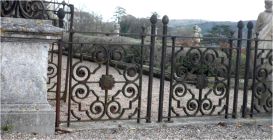 |
Stowford Lodge
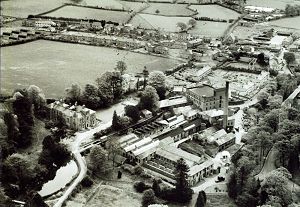 Mr John Allen purchased Stowford Paper Mill in Ivybridge in 1849. His residence was Stowford Lodge. There is much information on Ivybridge and its businesses and history on the ivybridge-history.org website. The Mill was a customer of G & K, not only whilst on the ownership of John Allen and subsequently his two sons but also through the Portals ownership and on through to the era of Wiggins Teape.
Mr John Allen purchased Stowford Paper Mill in Ivybridge in 1849. His residence was Stowford Lodge. There is much information on Ivybridge and its businesses and history on the ivybridge-history.org website. The Mill was a customer of G & K, not only whilst on the ownership of John Allen and subsequently his two sons but also through the Portals ownership and on through to the era of Wiggins Teape.
The Black & White Image shows the Mill Complex in the 1950s looking towards the South East. Stowford Lodge is central to the left in the image. The Mill Pond can be clearly seen in the bottom left hand corner of the image. There are suggestions that Garton & Jarvis may well have created and installed the cast iron balustrade for the Lodge staircase but as yet there is no real evidence of this as being correct.
Further information about the Heated Glasshouses and the cultivated garden area to the North of the of the Mill site can be found on the Hothouse Heating page and I have added a Map as well as brief details about the use of this area by the Miss May Crook FRHS and the Devon School of Gardening in the first decade of the 20th century.
One product John Allen personally ordered and had installed was a considerable length of Five Bar Fencing with seven eighths of an inch round bar at 3” and 9” gaps, cast iron standards and chain at the top. The cost per yard for all material, labour, carriage etc was calculated to be 8/- per yard. I may be corrected on this but this was erected on one side of the pathway (as seen) between Stowford Lodge and the walled Garden area.
Updated April 2022
Top of page
See also:
Gates — Monuments — Grave Markers
Third Rail, Hand Rail — Exeter Cathedral — Hothouse Heating
Sitemap / Contents